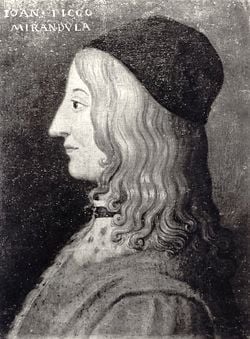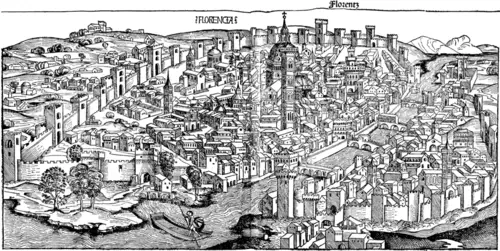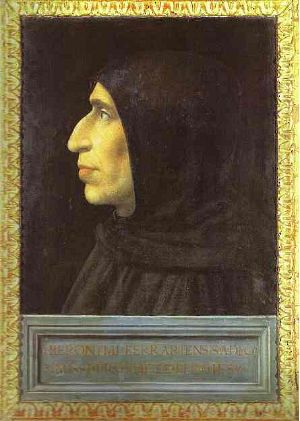Giovanni Pico della Mirandola
Giovanni Pico della Mirandola (February 24, 1463 – November 17, 1494) was an Italian Renaissance humanist philosopher and scholar, whose short influential life was brilliant, peripatetic, adventurous and almost theatrical in its eventfulness and intensity.
He is most celebrated for the events of 1486, when at the age of twenty-three, he proposed to defend 900 theses on religion, philosophy, natural philosophy and magic against all comers, for which he wrote the famous Oration on the Dignity of Man which has been called the "Manifesto of the Renaissance.", and a key text of Renaissance humanism. During the Medieval Ages, when God and the church were in the most exalted position, it was considered almost impossible to declare ”the Dignity of Man,” the concept which became the starting point of Renaissance humanism. Pico della Mirandola was one of the first to resurrect the humanism of ancient Greek philosophy. He also attempted a synthesis of great religious and philosophical truths.
Biography
Pico was a younger son of the family of the Counts of Mirandola and Concordia, feudal lords of a small region in the province of Emilia-Romagna. A precocious child with an amazing memory, he was schooled in Latin, and possibly Greek, at a very early age. Intended for the Church by his mother, he was named a papal protonotary at the age of ten and in 1477 he went to Bologna to study canon law.
At the sudden death of his mother two years later, Pico renounced canon law and began to study philosophy at the University of Ferrara. During a brief trip to Florence, he met Angelo Poliziano, the courtly poet Girolamo Benivieni and probably the young Dominican monk Savonarola. He would be very close friends with all three, including the ascetic and violently anti-humanist Savonarola, for the rest of his life.
From 1480 to 1482, he continued his studies at the University of Padua, a major center of Aristotelianism in Italy. Already proficient in Latin and Greek, he studied Hebrew and Arabic in Padua with Elia del Medigo, a Jewish Averroist, and read Aramaic manuscripts with him as well. Del Medigo also translated Judaic manuscripts from Hebrew into Latin for Pico, as he would continue to do for a number of years. Pico also wrote sonnets in Padua – both in Latin and in Italian – which he would destroy at the end of his life.
He spent the next four years either at home, or visiting humanist centers in Italy and in 1485, he traveled to the University of Paris, the most important center for Scholastic philosophy and theology in Europe – and a hotbed of secular Averroism. It was probably in Paris that Pico began his 900 Theses and conceived the idea of defending them in a public debate.
In 1484, he returned to Florence and met Lorenzo de' Medici and Marsilio Ficino, on the very day that Ficino completed his translations of the works of Plato from Greek into Latin under Lorenzo’s enthusiastic patronage. Pico charmed them both immensely. Until the day Lorenzo died, he would support and protect Pico through some very difficult times. Indeed, without Lorenzo, it is doubtful that Pico’s work would have survived.
Pico left for Rome, with the intention of publishing his 900 Theses and setting up a “Congress” of scholars from all over Europe to debate them. But on the way, stopping in Arezzo, he became embroiled in a love affair with the wife of one of Lorenzo de’ Medici’s cousins. It almost cost him his life. Pico attempted to run off with the woman, but he was caught, wounded and thrown into prison by her husband. He was released only upon the intervention of Lorenzo himself. The incident is wholly representative of Pico's often audacious temperament and of the loyalty and affection he nevertheless could inspire.
Pico spent several months in Perugia and nearby Fratta, recovering from his injuries. It was there, as he wrote to Ficino, that "divine Providence […] caused certain books to fall into my hands. They are Chaldean books […] of Esdras, of Zoroaster and of Melchior, oracles of the magi, which contain a brief and dry interpretation of Chaldean philosophy, but full of mystery."[1] It was also in Perugia that Pico was introduced to the mystical Hebrew Kabbalah, which fascinated him, as did the late Classical Hermetic writers, such as Hermes Trismegistus. The Kabbalah and the Hermetica were thought to be as ancient as the Old Testament in Pico's time, and for that reason, he accorded them an almost scriptural status. It was always Pico's intention to walk completely around a topic and look at it from many possible angles, in order to derive the truest possible vision of the thing itself. Syncretism, for Pico, was seeing the same absolute from many different points of view: an unusually modern approach.
Pico based his ideas chiefly on Plato, as did his teacher, Marsilio Ficino, but Pico retained a deep respect for Aristotle. Although he was a product of the studia humanitatis, Pico was constitutionally an eclectic, and in some respects he represented a reaction against the exaggerations of pure humanism, defending what he believed to be the best of the medieval and Islamic commentators (see Averroes, Avicenna) on Aristotle in a famous long letter to Ermolao Barbaro in 1485. It was always Pico’s aim to reconcile the schools of Plato and Aristotle, since he believed they both used different words to express the same concepts. It was perhaps for this reason his friends called him "Princeps Concordiae, or "Prince of Harmony" (a pun on Prince of Concordia, one of his family’s holdings.[2]) Similarly, Pico believed an educated person should also study the Hebrew and Talmudic sources, and the Hermetics, because he believed they represented the same view seen in the Old Testament, in different words, of God.
He finished his Oration on the Dignity of Man to accompany his 900 Theses and traveled to Rome to continue his plan to defend them. He had them published in December 1486 (Conclusiones philosophicae, cabalasticae et theologicae, Rome, 1486) and offered to pay the expenses of any scholars who came to Rome to debate them publicly.
In February 1487, Pope Innocent VIII halted the proposed debate, and established a commission to review the orthodoxy of the Theses. Although Pico answered the charges against them, thirteen of the Theses were condemned. Pico agreed in writing to retract them, but he did not change his mind about their validity, and proceeded to write an Apologia ("Apologia J. Pici Mirandolani, Concordiae comitis" published in 1489) defending them, dedicated to Lorenzo. When the Pope was apprised of the circulation of this manuscript, he set up an inquisitorial tribunal, forcing Pico to renounce the Apologia as well – which he also agreed to do.
Nevertheless, the Pope declared his Theses unorthodox calling them "in part heretical, in part the flower of heresy; several are scandalous and offensive to pious ears; most do nothing but reproduce the errors of pagan philosophers…others are capable of inflaming the impertinence of the Jews; a number of them, finally, under the pretext of "natural philosophy," favor arts that are enemies to the Catholic faith and to the human race."[3] One of Pico’s detractors maintained that "Kabbala" was the name of an impious writer against Jesus Christ. Pico fled to France in 1488, where he was arrested by Philippe de Savoie, at the demand of the papal nuncios, and imprisoned at Vincennes. Through the intercession of several Italian princes – all instigated by Lorenzo – King Charles VIII had him released, and the Pope was persuaded to allow Pico to move to Florence and to live under Lorenzo’s protection. But he was not cleared of the papal censures and restrictions until 1493, after the accession of Alexander VI (Rodrigo Borgia) to the papacy.
Pico was deeply shaken by the experience. He reconciled with Savonarola, who remained a dear friend, and it was at Pico’s persuasion that Lorenzo invited Savonarola to Florence. But Pico never renounced his syncretist convictions.
He settled in a villa near Fiesole prepared for him by Lorenzo, where he wrote and published the Heptaplus id est de Dei creatoris opere (1489) and De Ente et Uno (1491). It was here that he also wrote his other most celebrated work, the Disputationes adversus astrologiam divinicatrium, which was not published until after his death. In it, Pico acidly condemned the practices of the astrologers of his day, and shredded the intellectual basis of astrology itself. Pico was interested in high magic, that enhanced man's dignity and strengthened his will, and there was no room in such a concept for the determinism of the stars.
After the death of Lorenzo de' Medici, in 1492, Pico moved to Ferrara, although he continued to visit Florence, where political instability gave rise to the increasing influence of Savonarola, whose reactionary opposition to Renaissance expansion and style had already brought about conflict with the Medici family (they eventually were expelled from Florence), and would lead to wholesale destruction of books and paintings. Nevertheless, Pico became a follower of Savonarola, destroying his own poetry and giving away his fortune, with the determination of becoming a monk. However, he never did decide to make this final commitment.
Pico died under very mysterious circumstances in 1494 (it was rumored that his own secretary had poisoned him, because Pico had become too close to Savonarola[4]). He was interred at San Marco and Savonarola delivered the funeral oration. Ficino wrote: “Our dear Pico left us on the same day that Charles VIII was entering Florence, and the tears of men of letters compensated for the joy of the people. Without the light brought by the king of France, Florence might perhaps have never seen a more somber day than that which extinguished Mirandola’s light.”[5]
Writings
In the Oration on the Dignity of Man (1486), Pico justifies the importance of the human quest for knowledge within a neo-Platonic framework. He writes that after God had created all creatures, he conceived of the desire for another, sentient being who would appreciate all his works, but there was no longer any room in the chain of being; all the possible slots from angels to worms had been filled. So, God created man such that he had no specific slot in the chain. Instead, men were capable of learning from and imitating any existing creature. When man philosophizes, he ascends the chain of being towards the angels, and communion with God. When he fails to exercise his intellect, he vegetates. Pico did not fail to notice that this system made philosophers like himself among the most dignified human creatures. The idea that man could ascend the chain of being through the exercise of their intellectual capacities was a profound endorsement of the dignity of human existence in this earthly life. The root of this dignity lay in his assertion that only human beings could change themselves through their own free will, whereas all other changes in nature were the result of some outside force acting on whatever it is that undergoes change. He observed from history that philosophies and institutions were always in change, making man's capacity for self-transformation the only constant. Coupled with his belief that all of creation constitutes a symbolic reflection of the divinity of God, Pico's philosophies had a profound influence on the arts, helping to elevate writers and painters from their medieval role as mere artisans to the Renaissance ideal of the artist as genius.
The Oration also served as an introduction to Pico's 900 theses, which he believed to provide a complete and sufficient basis for the discovery of all knowledge, and hence a model for mankind's ascent of the chain of being. The 900 Theses are a good example of humanist syncretism, because Pico combined Platonism, Neoplatonism, Aristotelianism, Hermeticism and Kabbalah. They also included 72 theses describing what Pico believed to be a complete system of physics.
A portion of his Disputationes adversus astrologiam divinatricem was published in Bologna after his death. In this book Pico presents arguments against the practice of astrology that have had enormous resonance for centuries, up to our own time. Disputationes is influenced by the arguments against astrology espoused by one of his intellectual heroes, St. Augustine of Hippo, and also by ideas held by his teacher, Marsilio Ficino, who may have encouraged him to write it. Pico’s antagonism to astrology seems to derive mainly from the conflict of astrology with Christian notions of free will. But Pico’s arguments moved beyond the objections of Ficino (who was himself an astrologer). The manuscript was edited for publication after Pico’s death by his nephew, an ardent follower of Savonarola, and may possibly have been amended to be more forcefully critical. This might possibly explain the fact that Ficino championed the manuscript and enthusiastically endorsed it before its publication.
Pico’s Heptaplus, a mystico-allegorical exposition of the creation according to the seven Biblical senses, elaborates on his idea that different religions and traditions describe the same God. De ente et uno, has explanations of several passages in Moses, Plato and Aristotle.
Besides the writings already mentioned, see his complete works (Bologna, 1496; Venice, 1498; Strasburg, 1504; Basle, 1557; 1573, 1601). He wrote in Italian an imitation of Plato's Banquet. His letters (Aureae ad familiares epistolae, Paris, 1499) are important for the history of contemporary thought. The many editions of his entire works in the sixteenth century sufficiently prove his influence.
Footnotes
This article incorporates text from the public-domain Catholic Encyclopedia of 1913.
References and external links
Paul Oskar Kristeller, Eight Philosophers of the Italian Renaissance. Stanford University Press (Stanford California, 1964.) A reader that includes the complete Oration on the Dignity of Man.
Ernst Cassirer, Paul Oskar Kristeller and John Herman Randall, Jr., The Renaissance Philosophy of Man. The University of Chicago Press (Chicago, 1948.)
Walter Pater, The Renaissance. (1871) Modern Library, New York City. Pp. 24-40.
- The Pico Project at the University of Bologna and Brown University is a project to make accessible a complete resource for the reading and interpretation of the Dignity of Man.
- Giovanni Pico della Mirandola, Oration on the Dignity of Man, translated by A. Robert Caponigri (Chicago: Regnery Publishing, 1956).
- Pico in English: A Bibliography, the works of Giovanni Pico della Mirandola (1463-1494), with a List of Studies and Commentaries.
- http://www.lyber-eclat.net/lyber/mirandola/picbio.html
- Pico della Mirandola by Richard Hooker, 6 June 1999.
Credits
New World Encyclopedia writers and editors rewrote and completed the Wikipedia article in accordance with New World Encyclopedia standards. This article abides by terms of the Creative Commons CC-by-sa 3.0 License (CC-by-sa), which may be used and disseminated with proper attribution. Credit is due under the terms of this license that can reference both the New World Encyclopedia contributors and the selfless volunteer contributors of the Wikimedia Foundation. To cite this article click here for a list of acceptable citing formats.The history of earlier contributions by wikipedians is accessible to researchers here:
The history of this article since it was imported to New World Encyclopedia:
Note: Some restrictions may apply to use of individual images which are separately licensed.


